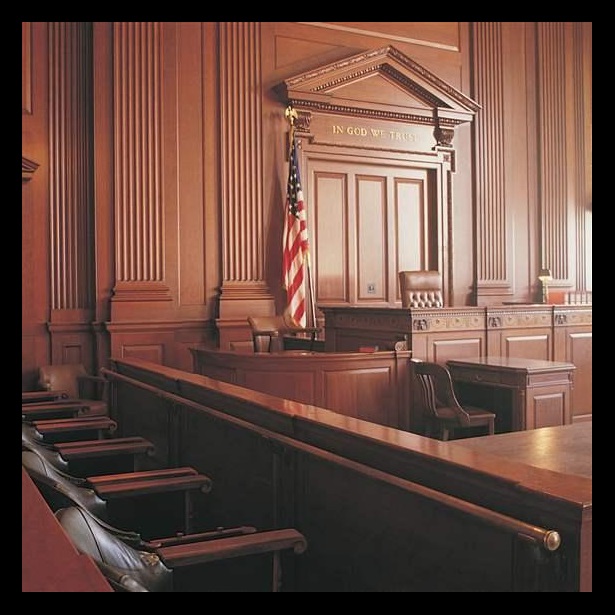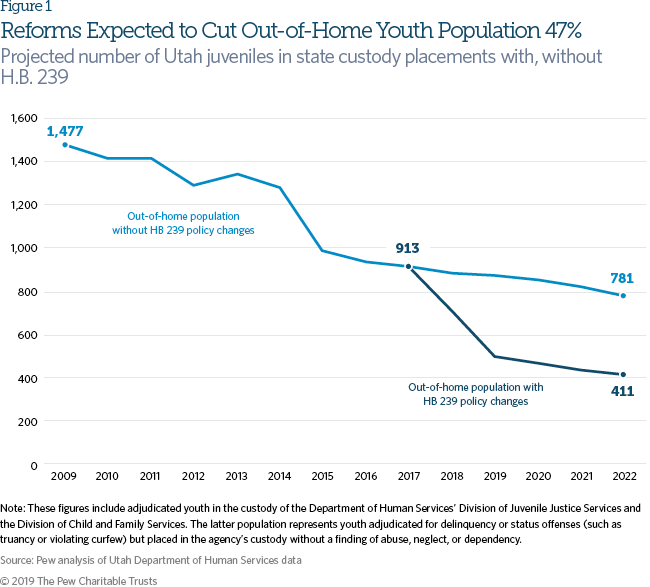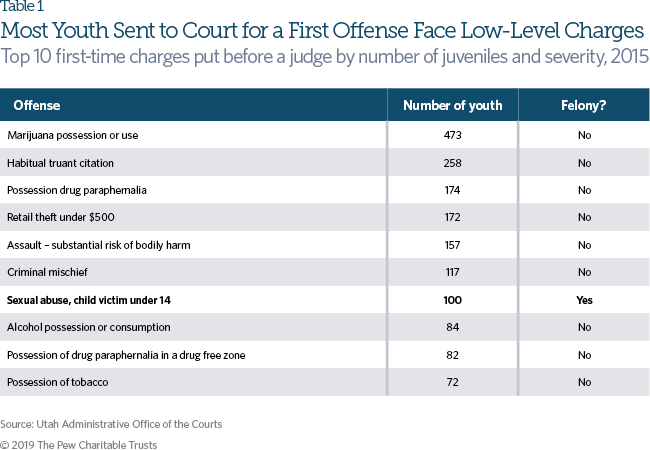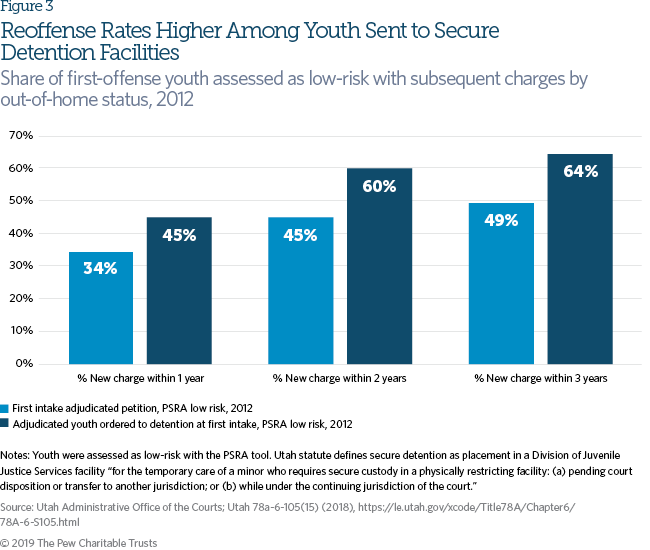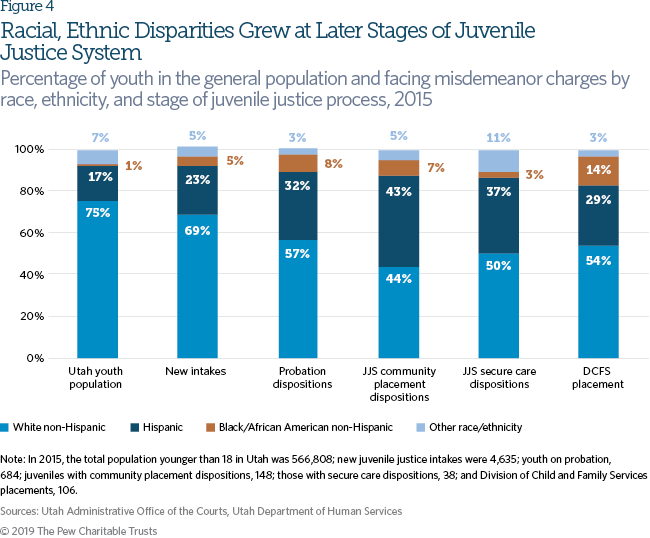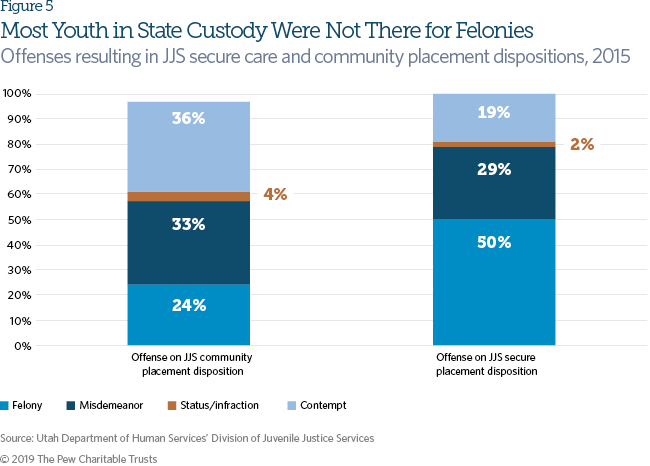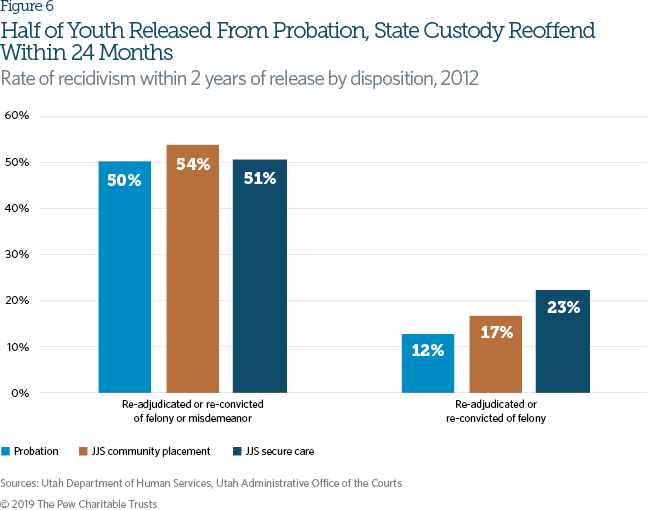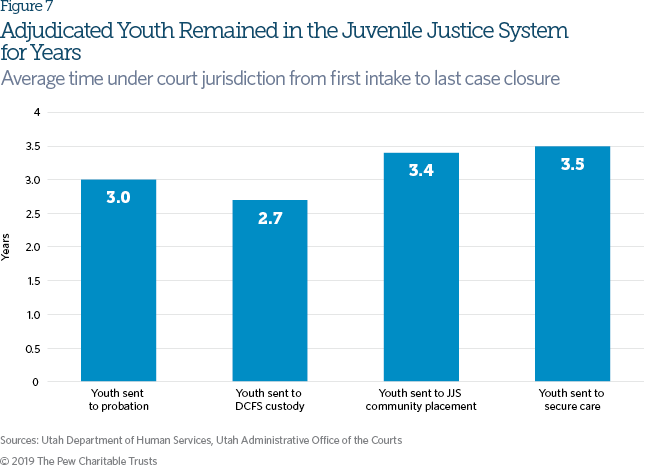Utah’s 2017 Juvenile Justice Reform Shows Early Promise
Law aims to improve public safety outcomes across the state

This issue brief was updated on May 23, 2019, to clarify the share of youth in the Division of Juvenile Justice Services’ secure care who were charged with felonies.
Overview
On March 24, 2017, Utah Governor Gary Herbert (R) signed H.B. 239, a comprehensive set of research-based reforms designed to improve the state’s juvenile justice system. The bill, which was sponsored by Representative Lowry Snow (R) and Senator Todd Weiler (R) and passed with near-unanimous support in the Legislature, is intended to keep youth who can be safely supervised in the community out of costly residential placements, expand community-based programs, standardize practices to reduce outcome disparities across racial and geographic lines, and divert youth charged with less serious offenses from formal court proceedings.
The Legislature also appropriated approximately $1 million in initial funding for the expansion of evidence-based services and other provisions of the new law. By 2022, H.B. 239 is projected to reduce the number of juveniles in out-of-home placements by approximately 47 percent, freeing up $70 million for reinvestment in evidence-based services in the community. (See Figure 1.)
Background
In June 2016, Gov. Herbert, Chief Justice Matthew Durrant, Senate President Wayne Niederhauser (R), and House Speaker Gregory Hughes (R) established the 19-member Utah Juvenile Justice Working Group to develop policy recommendations that would promote public safety, limit system costs, reduce recidivism, and improve outcomes for youth, families, and communities. These leaders expressed a desire to build on the state’s 2015 Justice Reinvestment Initiative, an effort that used data and research to improve public safety outcomes within Utah’s adult criminal justice system. The working group included legislators, judges, state agency directors, a chief of police, a defense attorney, and an education stakeholder, among others.
Members of the Utah Juvenile Justice Working Group
- Ron Gordon, executive director, Utah Commission on Criminal and Juvenile Justice (chair)
- State Senator J. Stuart Adams (R-22nd)
- State Senator Todd Weiler (R-23rd)
- State Representative Eric Hutchings (R-38th)
- State Representative Lowry Snow (R-74th)
- Judge Michelle Heward, 2nd Judicial District
- Judge James Michie, 3rd Judicial District
- Judge Ryan Evershed, 8th Judicial District
- Steve Anjewierden, chief of police services, Unified Police Department of Greater Salt Lake
- Susan Burke, director of juvenile justice services, Department of Human Services (DHS)
- Charri Brummer, deputy director, Division of Child and Family Services, DHS
- Darin Carver, clinical practice administrator
- Maria Garciaz, executive director, NeighborWorks Salt Lake
- Carolyn Hansen, associate director, Salt Lake County Division of Youth Services
- Steve Kaelin, alternative and adult education specialist, Utah State Board of Education
- Troy Rawlings,county attorney, Davis County
- Dawn Marie Rubio, juvenile court administrator, Utah Administrative Office of the Courts
- Doug Thomas, director, Division of Substance Abuse and Mental Health, DHS
- Pam Vickrey, executive director, Utah Juvenile Defender Attorneys
Throughout the second half of 2016, the working group assessed the state’s juvenile justice system, reviewing extensive data from courts and agencies serving youth, and gathered input through three statewide questionnaires of juvenile court judges, probation officers, and case managers, and more than 30 roundtables with a diverse array of stakeholders. After comparing its findings with research on effective approaches to reducing recidivism as well as successful policies and practices in other states, the working group developed a set of policy recommendations that was reviewed and approved by the state’s Commission on Criminal and Juvenile Justice. The Pew Charitable Trusts and the Crime and Justice Institute at Community Resources for Justice provided technical assistance.
Key findings
Most youth faced low-level charges, but responses were inconsistent
Data showed that most youth referred to the Utah juvenile justice system entered with low-level charges, such as truancy and possession of marijuana or drug paraphernalia.1 More than 80 percent of those referred for the first time were at low risk to reoffend, according to Utah’s validated assessment tool, the Pre-Screen Risk Assessment (PSRA). State law allowed juveniles facing a broad array of charges to be diverted from formal judicial processing through a pre-court “nonjudicial adjustment.” However, eligibility criteria and diversion rates varied by region. For example, data showed that in the 7th Judicial District, more than two-thirds of youth charged with a Class B misdemeanor or lower received a nonjudicial adjustment, compared with only about a third of similarly charged juveniles in the 1st Judicial District. Statewide, minor charges made up most of the top offenses among youth sent to court for their first offense. (See Table 1.)
The working group found that outcomes differed for youth who received nonjudicial adjustments and those who appeared before a judge. A higher proportion of juveniles charged with misdemeanors and status offenses who went to court for their first case had subsequent charges compared with those who received a nonjudicial adjustment, even when the initial charges were similar for both groups. (See Figure 2.)
Youth often securely detained before adjudication on low-level nonviolent charges
In 2015, law enforcement agencies in Utah booked more than 400 juveniles facing first-time charges into secure detention facilities before adjudication. Although the state Division of Juvenile Justice Services (JJS) rules banned admission for most lower-level offenses, they allowed detention for youth facing multiple, simultaneous charges, even if they were minor. Partly as a result, even with the JJS prohibition, three of the top four charges for which youth were detained were misdemeanors.
Research shows that detaining youth can increase the likelihood of recidivism.2 But despite this evidence, the working group found that 44 percent of youth detained before adjudication were deemed at low risk to reoffend by PSRA and that those juveniles reoffended at higher rates than those who were not confined or given an order of suspended detention. (See Figure 3.)
Lack of statewide disposition standards led to inconsistent responses
Before H.B. 239, Utah statute gave judges wide discretion in juvenile cases, leading to significant geographic variation in the use of out-of-home placement. Sentencing guidelines existed but were not binding, and 77 percent of juvenile court judges reported to the working group that they sometimes or always departed from the guidelines. The working group also found that courts in some districts used a disproportionately high share of serious dispositions, such as detention, relative to the number of youth referred to the system in those districts. For example, the 2nd Judicial District accounted for 18 percent of the state’s new court intakes in 2015 but represented 32 percent of JJS detention dispositions and bookings across all offense categories, indicating that the types of cases the district’s courts handled did not explain the extensive use of detention.
In addition, the working group found that state law allowed courts to place youth in the custody of the Division of Child and Family Services (DCFS)—the state’s child welfare agency—without a finding of abuse, neglect, or dependency. Because these placements lacked a child welfare basis, the juveniles involved did not receive the statutory protections usually afforded by the child welfare code, and their average length of confinement was far longer than even that of youth placed at the most secure level of JJS custody.
Racial and ethnic disparities in probation and custody dispositions also emerged from the working group’s analysis. These discrepancies increased as youth reached the deeper stages of the system and were most significant among juveniles removed from their homes. (See Figure 4.) These differences were still apparent even after accounting for the severity of the offenses committed, such as misdemeanors. (See Figure 4.)
Costly out-of-home placements were common for low-level offenses, despite poor public safety benefits
Research shows that removing youth from their homes does not typically improve outcomes and can increase the likelihood of reoffending.3 In Utah, judges had discretion to remove juveniles from their homes and place them in state custody for nearly any offense, regardless of severity or the youth’s risk level. Data showed that felonies represented just 24 percent of dispositions to JJS community placement and 50 percent of those to JJS secure care—the most intensive response available to the court. (See Figure 5.) Many youth placed in state custody had little or no prior offense history.
Further, the working group found that youth were most commonly removed from their homes for contempt— that is, failure to follow a rule set by the court, such as missing curfew or an appointment with a probation officer.
Mirroring findings in other states, the working group found that out-of-home placement was substantially more expensive than probation. The state paid up to $127,750 a year per youth in a JJS facility, 17 times more than a year of probation for one youth. Despite the higher cost, removing youth from their homes did not produce lower recidivism rates: Roughly half of juveniles released from probation and out-of-home placement were adjudicated for a new offense or convicted in the adult system within two years. (See Figure 6.)
Once involved with the juvenile justice system, youth remained so for years
Research has not demonstrated a consistent relationship between longer stays in out-of-home placement and lower rates of reoffending; one study found no marginal public safety benefit from out-of-home terms longer than three months.4 In addition, many of the most common evidence-based programs shown to reduce reoffending are designed to last three to four months. In Utah, however, the working group found that, once referred, youth typically remained under the juvenile justice system’s authority for significantly longer.
One problem was the lack of statutory limitations or guidance on the length of time a youth could spend in custody, on probation, or under the jurisdiction of the court. For juveniles removed from their homes, the average disposition for JJS nonsecure placement was nearly 10 months, while the average length of secure placement dispositions was more than 14 months. Overall, youth placed on probation or in custody were monitored by the juvenile justice system for an average of three years. (See Figure 7.) As one youth told the working group, “The system feels like once you’re in it, it’s almost impossible to get out.”
Families, probation officers, youth, and agency staff told the working group that one reason youth often struggled to complete supervision was the onerous terms imposed by the court. Utah’s juvenile courts set 18 standard probation conditions, as well as other statutorily mandated requirements (such as license suspensions and drug treatment), regardless of the child’s age, eligibility to drive, or need for treatment. The working group further found that youth often were ordered to pay significant fines and fees, and complete lengthy periods of community service. From 2011 to 2015, court-ordered community service averaged just over 73 hours per case, with one youth ordered to complete 1,864 hours—nearly a year of full-time community service.5
Then, when juveniles struggled to meet demanding financial or service obligations, courts often placed them in work camps. These facilities cost the state $208 per youth per day, but an eight-hour day of labor yielded only about $50 toward repayment of a youth’s financial obligations. Eventually, as these debts went unpaid, they were transferred to private collections firms, which the working group found often charged youth inflated interest rates but rarely recovered the financial compensation due to courts and victims.
Evidence-based alternatives to out-of-home placement largely unavailable
A wide range of stakeholders told the working group that an absence of high-quality services for juveniles living at home contributed to the extensive use of state custody. Research shows that for most youth, participation in evidence-based programs in the community yields better public safety outcomes and costs significantly less than removal from the home.6
In questionnaires and roundtables, judges, probation officers, facility staff, and others reported that the availability of effective services varied widely, with greater scarcity in rural areas, and that where services did exist, juveniles often faced obstacles, such as lack of transportation, high costs, or long waits. One probation officer told the working group, “One of the things that really frustrates us is the lack of services and the lack of quality services for our kids, because we do end up moving them along farther into the system to meet their needs [when they] could have their needs addressed in the community.”
H.B. 239: Comprehensive juvenile justice legislation
In November 2016, the working group delivered to state leadership 55 policy recommendations that became the foundation of H.B. 239, which passed with unanimous Senate support and a bipartisan vote of 67-4 in the House of Representatives. Gov. Herbert signed it March 24, 2017. By 2022, the legislation is projected to reduce Utah’s out-of-home juvenile population by nearly half, freeing up $70 million for reinvestment in community programs that strengthen families and reduce recidivism. Some of the law’s key components are summarized below.
Minimize involvement of youth charged with lower-level offenses in the justice system
- Remove low-level, school-based offenses from juvenile court jurisdiction: H.B. 239 requires that low-level offenses—e.g., truancy, the lowest-level misdemeanors, and infractions such as disruption, and disorderly conduct—committed on school grounds during operating hours be handled without court intervention.
- Expand authorization and funding for community-based alternatives to court processing: H.B. 239 requires a statewide increase in the availability of interventions that enable law enforcement and school staff to respond effectively to juveniles without formally involving the justice system. Required programs include receiving centers that provide counseling and temporary shelter, mobile outreach teams serving youth in behavioral crisis, and alternative restorative justice programs, such as youth court.
- Standardize and expand pre-court diversion: To ensure that juveniles across Utah are treated consistently by the justice system, H.B. 239 establishes statewide criteria for nonjudicial adjustments. The law requires that intake officials offer all youth referred for infractions, status offenses, or misdemeanors the option of nonjudicial adjustments unless the juveniles have more than three prior adjudications or have failed at four or more previous nonjudicial adjustments. Intake staff are also authorized to withhold that offer if a youth is rated high-risk by a validated risk and needs assessment or is charged with certain offenses.7H.B. 239 prohibits the state from denying youth access to a nonjudicial adjustment based on inability to pay fees, fines, or other financial penalties
Prioritize secure detention for youth who pose a serious public safety threat
- Expand effective alternatives to secure detention: The law mandates the expansion of in-home detention (a community-based alternative to secure detention) and receiving centers, which can serve as temporary shelters while youth and families receive counseling, to every judicial district in the state.
- Enhance standards for pre-adjudication secure detention: Under H.B. 239, a risk assessment must be used to guide detention admissions decisions, and JJS must revise administrative rules governing detention eligibility. The court may place a juvenile in detention before adjudication only if it finds that releasing him or her would pose an unreasonable risk to public safety and that all less-restrictive alternatives have been considered.
- Limit cumulative detention: The law restricts the use of secure detention as a disposition to 30 days over the course of a case. Although pre-adjudication confinement time is not limited, if it reaches 30 days, at disposition, detention may not be ordered and the youth must get credit for time already served.
- Limit use of warrants for low-level offenses: H.B. 239 prohibits courts from issuing arrest warrants for juveniles charged with infractions or status offenses, or if the sole rationale for seeking custody is to protect the welfare of the minor. Instead of issuing warrants and detaining youth in these cases, the court may direct that a child be picked up and taken home or to a receiving center.
- Limit detention for youth awaiting placement: The law establishes a 72-hour secure detention limit post-disposition for youth awaiting placement, with an available extension and reports to the court every 48 hours if a placement has not been found.
- Limit court reliance on secure detention for contempt: H.B. 239 limits the time a juvenile can spend in detention for contempt of court to 72 hours.
- Moderate financial obligations to promote accountability: H.B. 239 limits fines and court fees to reflect the age at which a youth can legally obtain work, instituting a cap of $180 for youth younger than 16 and $270 for those 16 and older. The law also specifies that outstanding financial obligations may not be transferred to the Office of State Debt Collection. Finally, the law requires that restitution be ordered only for material loss and that it be waived if the court finds that the juvenile is unable to pay.
- Create a new presumption for community service hours: H.B. 239 removes mandatory community service provisions, creates a standard order of five to 10 hours’ service for all youth, and caps service hours by age. For those 16 and older at the time of adjudication, courts may impose no more than 36 hours of service, and for those younger, no more than 24 hours.
- Authorize and expand restorative justice programs: With agreement from victims and youth, the court may refer cases to a restorative justice program, an intervention that focuses on repairing harm by, for example, facilitating mediation between the victim and the juvenile to instill accountability. H.B. 239 also prioritizes statewide expansion of victim-offender mediation programs using reinvestment funds.
Strengthen community supervision
- Expand the use of validated tools to prioritize resources for youth at highest risk to reoffend: The law requires that all juveniles undergo a risk and needs assessment—if it is deemed necessary during intake—to inform disposition. The risk assessment must be conducted within seven days of the conclusion of the case to determine whether the youth’s risk has changed during his or her time in the system.
- Tailor supervision and services to youth risk and needs: The law requires development of individualized case plans in consultation with youth and their families for all juveniles on probation and in JJS custody. Plans must be based on assessed risks and needs, and tailored to address current offenses and any history of court involvement. The law eliminates uniform statutory treatment requirements and gives courts discretion to order treatment if consistent with assessed risks and needs, and ends mandatory driver’s license suspensions for certain offenses.
- Develop a continuum of community-based responses to undesirable behavior: Under the law, Utah will develop a system of community-based graduated responses, including incentives and sanctions, for youth under supervision that can be tailored to each juvenile’s needs and risk of reoffending. The law also requires the state’s Sentencing Commission—a body responsible for advising the Legislature, governor, and Judicial Council regarding sentencing and release policy—to establish guidelines for incentives and sanctions, including earned discharge credit for good behavior.
- Improve fairness of the parole revocation process: H.B. 239 enhances due process for youth on parole by requiring that hearings on possible violations take place within a designated time frame.
Prioritize confinement for youth who pose the greatest risk to public safety
- Reserve the most intensive responses for the most serious cases: H.B. 239 requires that specific criteria be met before a youth can be placed out of his or her home.
- Prioritize JJS custody for youth who commit serious offenses or have extensive offense histories: Under the law, juveniles may be placed in JJS custody only if they commit a felony, a misdemeanor involving the use of a dangerous weapon, or any misdemeanor after at least five prior misdemeanor or felony adjudications. In all cases, the court must determine that nonresidential options have been exhausted or are not appropriate. To commit a youth to secure confinement, the court must find that the youth meets all criteria for out-of-home placement and poses a risk of harm to others.
- Limit the use of custody for contempt of court and other behaviors that are not new crimes: H.B. 239 prohibits the court from committing a youth to JJS custody based on contempt of court, a violation of probation, failure to pay financial obligations, unfinished community services hours, an infraction, or a status offense. As a result, the law closes JJS work camps, facilities that Utah previously used to house youth required to work off court-ordered financial obligations.
- Eliminate DCFS custody without a child-welfare finding: Under H.B. 239, courts may no longer place delinquent youth in DCFS custody without a corresponding finding of abuse, neglect, or dependency. In cases involving delinquent youth and child welfare concerns, the court may order a DCFS assessment and, if the agency deems it necessary, require that in-home family services be provided.
- Eliminate removal from home for the purposes of assessment and create nonresidential alternatives: The law replaces residential “observation and assessment” programs with nonresidential evaluations. Courts still may seek evaluation services, but out-of-home placement exclusively for that purpose is no longer permitted.
- Limit supervision lengths consistent with evidence-based timelines: H.B. 239 sets standard timelines of three to six months for out-of-home placements, three months for intake probation, four to six months for formal probation, and three to four months for aftercare. The law also creates clear guidelines for extension of these timelines.
- Expand discretion to determine court jurisdiction: Before passage of H.B. 239, Utah automatically prosecuted youth in the adult system if they had previously been committed to a secure juvenile facility for certain offenses. Now, the law instead gives juvenile courts the authority to decide appropriate jurisdiction over these cases.
Reinvest in services in the community while improving system accountability and performance
- Reinvest in effective community-based interventions: The Utah Legislature designated $1 million in ongoing appropriations to support the implementation of H.B. 239, and the law directs the state’s Commission on Criminal and Juvenile Justice’s (CCJJ’s) Juvenile Justice Oversight Committee to calculate averted costs from reductions in out-of-home placements and prioritize reinvestment of those savings in community programs. Through these allocations, H.B. 239 will expand access to a broad range of services, including early interventions outside the justice system—such as family wraparound services and truancy prevention—as well as evidence-based programs for youth on probation assessed as moderate- and high-risk.
- Create a performance-based contracting system: The law requires JJS to develop a contracting system that uses metrics to ensure that programs in facilities produce improved outcomes.
- Require that all programming be evidence-based: H.B. 239 mandates that all programs offered by JJS must be evidence-based and proved to reduce reoffending.
- Establish a statewide oversight committee: The law requires the creation of an oversight committee to monitor the implementation of H.B. 239. The committee will establish performance measures, collect and report data on those metrics, monitor implementation of policy provisions, oversee public outreach related to H.B. 239, help state agencies develop policies and tools, and oversee reinvestment of savings.
- Provide training on best practices across the juvenile justice system: H.B. 239 directs CCJJ to help responsible agencies develop training for law enforcement, judges, prosecutors, JJS staff, and other juvenile justice system professionals on adolescent development, implicit bias, cultural competence, graduated responses, and additional topics.
Early results from Utah reforms
The full impact of H.B. 239 will take years to materialize as new policies and practices are phased in across the state. Still, in the initial years after the launch of system improvements, early signs indicate progress. The entire range of H.B. 239 policies designed to reduce the out-of-home population will not take full effect until July 1, 2019. But in July 2018, DHS reported $18.9 million in reinvestment and reallocation of current resources into service expansion in the community.8 Expanded services funded through the savings include:
- Access in every county to nonresidential services both for youth involved with the courts and for those in need of services outside of the juvenile justice system.
- Access in every school district to at least one alternative program for addressing youth behavior without a court referral.
- Incentives for evidence-based at-home services in rural areas.
- Expansion of home detention to every judicial district as an alternative to detention.
- New receiving centers in rural areas to provide stabilization and mobile response services.
- Outpatient evaluation, substance use and mental health treatment, and wraparound services with family and youth peer support.
- Additional supports for youth transitioning home from out-of-home placement, including transportation.
In its annual report released in January 2019, the Juvenile Justice Oversight Committee found that since the reforms were enacted:
- Fewer youth are entering the juvenile justice system. The long-term trend of declining juvenile court referrals continued as they fell another 23 percent between fiscal years 2016 and 2018.
- Rates of diversion from court through nonjudicial adjustment rose substantially. Between fiscal 2016 and 2018, the share of court referrals that resulted in a nonjudicial adjustment increased 224 percent, reaching 55 percent of all referrals in fiscal 2018. (See Figure 8.) This trend extended across every judicial district, and among youth referred to court who were assessed as low-risk on the PSRA, 78 percent received a nonjudicial adjustment offer.
- Detention admissions are down 44 percent between fiscal 2016 and 2018, including a 69 percent decline for contempt. At the same time, JJS expanded home detention programs, ensuring that every judicial district in the state has access to at least one nonresidential detention alternative. In January 2017, JJS closed two detention units at Salt Lake Valley Detention Center and Slate Canyon Youth Center because of a drop in nightly bed counts.
- JJS nonsecure out-of-home placement continues to decline. The number of youth in community placement during the first quarter of fiscal 2018 was down 29 percent from the same period two years before, in keeping with the long-term trend.
In the year after passage of H.B. 239, Juvenile Justice Oversight Committee members helping with implementation of the law reached out to stakeholders to explain the changes and gather input.
As part of this process, more than 500 people attended 18 meetings across the state, providing feedback that led Rep. Snow to sponsor follow-up legislation (H.B. 132) during the 2018 session.
Passed by the Legislature and signed by the governor in 2018, the new law clarified some aspects of the 2017 reform law and made minor substantive changes to others. H.B. 132:
- Clarified school resource officers’ role in responding to public safety issues in schools.
- Delayed implementation of prohibitions on court referral for low-level offenses that take place in school as alternative responses are established and expanded around the state.
- Increased school districts’ discretion to use education funds for truancy prevention.
- Authorized school districts to work with the Utah State Board of Education and the courts to expand resources for alternative responses to misbehavior by youth in schools.
- Allowed suspended orders for JJS custody to be imposed for technical violations without a new charge for the first three months the order is in place, but only if youth have a newly assessed need and defense counsel has been notified.
- Clarified and modified the nonjudicial adjustment process and eligibility criteria.
- In 2019, Rep. Snow led a successful effort to enact another piece of legislation, H.B. 404, which will provide a statutory structure to ensure sustained reinvestment in services in the community.
Providing Youth With Defense Counsel: A Continuing Challenge
During the Utah Juvenile Justice Working Group’s assessment of the juvenile justice system, judges reported that youth frequently lacked appropriate legal representation.
A questionnaire completed by nearly every judge in the state confirmed these concerns, with just 38 percent of respondents reporting that defense counsel was appointed for all types of offenses. (See Table 2.) Even when an attorney was appointed at the start of the case, only 35 percent of respondents said defense counsel was present at subsequent detention hearings.
Some respondents went further, noting that prosecutors were often not present at adjudication or disposition, raising the possibility that in certain areas of the state, judges were at times the only lawyers in the courtroom for key hearings. Youth in secure facilities echoed these findings, with many reporting to the working group that they had no lawyer during the court process.
Although misdemeanors and contempt of court were the most common charges—including for out-of-home placement hearings—Utah statute required appointment of counsel only for felony charges, even if the underlying offense on a contempt charge was a felony. To address these concerns, the working group recommended that legal counsel be appointed in all juvenile court cases, that the appointment remain in place until the case is resolved, and that the state create an entity to oversee issues related to juvenile defense counsel. These measures were included in H.B. 239 as introduced but were removed before final passage.
In March 2019, Gov. Herbert signed S.B. 32, sponsored by Sen. Weiler, to expand juveniles’ access to legal counsel and set standards for the quality of that representation. This new law creates a presumption that all youth are indigent for the purposes of appointment of counsel and requires the court to order representation at every proceeding. To support the expansion of juvenile representation, the Legislature appropriated roughly $840,000 in ongoing funds.
Acknowledgments
This brief was prepared by Noah Bein and Ruth Rosenthal of Pew’s public safety performance project and Margot Isman of the Crime and Justice Institute (CJI), with assistance from Pew staff members Jake Horowitz and Dana Shoenberg. Current and former Pew and CJI staff members Maria Borden, Jennifer V. Doctors, Adam Fifield,Pam Lachman, Krista MacPherson, Cindy Murphy-Tofig, Jennifer Peltak, Tessa Upin, and Liz Visser provided editing, design, and web support.
Endnotes
- Unless otherwise cited, all analyses in this report were conducted by The Pew Charitable Trusts and the Crime and Justice Institute at Community Resources for Justice using data drawn from Utah’s Court and Agencies Record Exchange (CARE) system, which houses data collected by the Administrative Office of the Courts and the Department of Human Services Division of Juvenile Justice Services.
- Anna Aizer and Joseph J. Doyle Jr., “Juvenile Incarceration, Human Capital, and Future Crime: Evidence From Randomly Assigned Judges,” The Quarterly Journal of Economics 130, no. 2 (2015): 759-803, https://doi.org/10.1093/qje/qjv003; Charles E. Frazier and John C. Cochran, “Detention of Juveniles: Its Effects on Subsequent Juvenile Court Processing and Decisions,” Youth and Society 17, no. 3 (1986): 286-305, https://doi.org/10.1177/0044118X86017003005; Daniel P. Mears et al., “The ‘True’ Juvenile Offender: Age Effects and Juvenile Court Sanctioning,” Criminology 52, no. 2 (2014): 169-94, https://doi.org/10.1111/1745-9125.12034.
- Edward P. Mulvey et al., “Trajectories of Desistance and Continuity in Antisocial Behavior,” Development and Psychopathology 22, no. 2 (2010): 453-75, https://doi.org/10.1017/S0954579410000179; Daniel S. Nagin, Francis T. Cullen, and Cheryl Lero Jonson, “Imprisonment and Reoffending,” Crime and Justice 38, no. 1 (2009): 115-200, http://dx.doi.org/10.1086/599202; Martin Killias, Patrice Villettaz, and Isabel Zoder, “The Effects of Custodial vs. Non-Custodial Sentences on Re-Offending: A Systematic Review of the State of Knowledge,” Campbell Systematic Reviews 20, no. 1 (2006): 29-34, http://library.college.police.uk/docs/Killias-custodial-2006.pdf; Christopher T. Lowenkamp and Edward J. Latessa, “Evaluation of Ohio’s Reclaim Funded Programs, Community Corrections Facilities, and DYS Facilities” (2005) University of Cincinnati, Division of Criminal Justice, https://www.uc.edu/content/dam/uc/ccjr/docs/reports/project_reports/Final_DYS_RECLAIM_Report_2005, pdf; Paula Smith, Claire Goggin, and Paul Gendreau, “The Effects of Prison Sentences and Intermediate Sanctions on Recidivism: General Effects and Individual Differences” (2002) Department of Psychology and Centre for Criminal Justice Studies, University of New Brunswick, Saint John, https://www.publicsafety.gc.ca/cnt/rsrcs/pblctns/ffcts-prsn-sntncs/index-en.aspx.
- Thomas A. Loughran et al., “Estimating a Dose-Response Relationship Between Length of Stay and Future Recidivism in Serious Juvenile Offenders,” Criminology 47, no. 3 (2009): 669-740, https://www.ncbi.nlm.nih.gov/pmc/articles/PMC2801446.
- This information derives from an analysis of juvenile court community service data by the Commission on Criminal and Juvenile Justice using data provided by the Administrative Office of the Courts. The figures cited here reflect the number of community service hours imposed on a given date; the total number of cumulative community service hours a youth received over the course of multiple court dispositions could be higher.
- Mulvey et al., “Trajectories of Desistance”; Nagin, Cullen, and Jonson, “Imprisonment and Reoffending”; Killias, Villettaz, and Zoder, “The Effects of Custodial vs. Non-Custodial Sentences”; Lowenkamp and Latessa, “Evaluation of Ohio’s Reclaim Funded Programs”; Smith, Goggin, and Gendreau, “The Effects of Prison Sentences.”
- H.B. 132, a follow-up bill enacted during the 2018 legislative session, added a provision requiring that a prosecutor, rather than intake staff, review referrals to determine whether an offer of nonjudicial adjustment is appropriate if the youth has another open case with a suspended custody order or if the youth is charged with any of the following offenses: driving under the influence; reckless endangerment creating a substantial risk of death or serious bodily injury; negligent homicide; sexual battery; possession of a dangerous weapon, firearm, or short-barreled shotgun on or about school premises; or minor in possession of a firearm.
- Utah Department of Human Services, “Report to the Juvenile Justice Oversight Committee” (2018).


America’s Overdose Crisis
Sign up for our five-email course explaining the overdose crisis in America, the state of treatment access, and ways to improve care
Sign up

Probation and Parole Systems Marked by High Stakes

